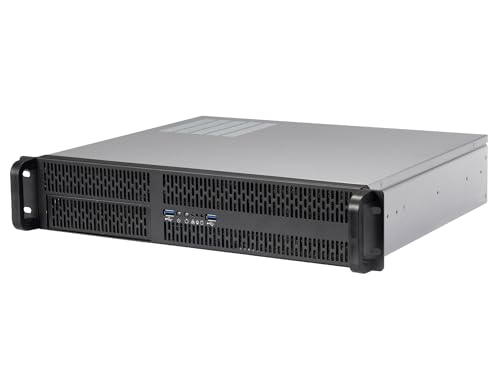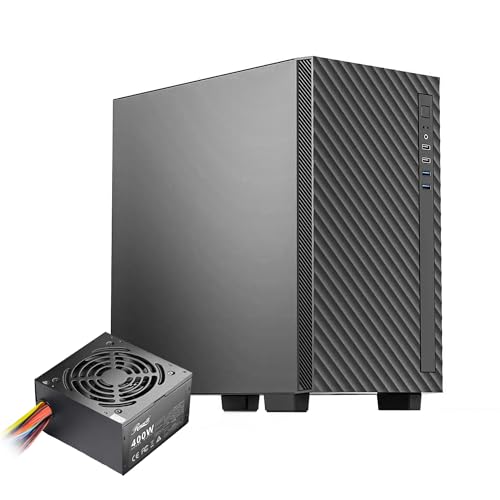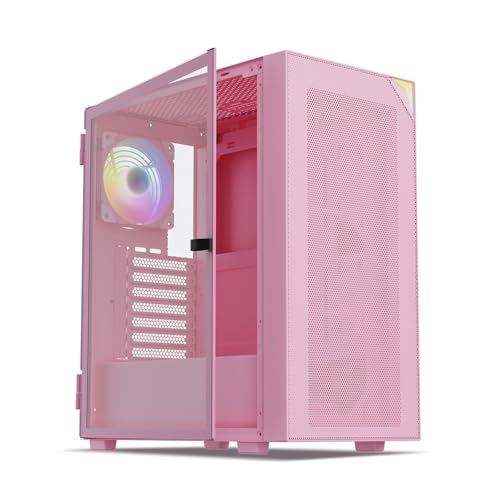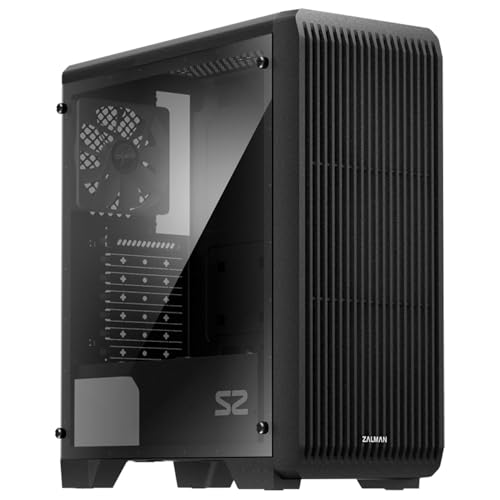There comes a point in every tech enthusiast’s journey when the collection of repurposed desktops, humming away in a corner as makeshift servers, becomes untenable. For me, that moment arrived when the “server closet”—which was really just the corner of my home office—began to resemble an electronic junkyard. The noise was a constant hum, the heat was noticeable, and the cable management was, to put it mildly, a Lovecraftian horror. I needed to centralize, to organize, to bring order to the chaos. The dream was a proper server rack, but the reality was a budget that laughed at enterprise-grade hardware prices. This is the exact predicament that leads someone to search for a product like the Rosewill RSV-Z2700U 2U Rackmount Server Chassis. It promises a bridge between the consumer desktop world and the professional rackmount environment without demanding a second mortgage.
- Roomy Chassis: This 2U server case has 4 internal 3.5” HDD bays plus room for 1 additional 5.25” devices.
- Expandable Design: 4 PCI slots and Micro-ATX compatibility for flexible expansion options.
Before You Rack: What to Consider When Buying a Server Chassis
A server chassis is more than just a metal box; it’s a key solution for consolidating hardware, optimizing airflow for 24/7 operation, and maximizing physical space. Unlike a standard desktop tower that’s designed for aesthetics and easy access, a rackmount chassis prioritizes density, standardization, and efficient cooling within an enclosed environment. It’s the foundation of a clean, manageable, and scalable home server setup, whether you’re running a media server like Plex, a home automation hub, a personal cloud, or a virtual machine lab.
The ideal customer for this type of product is someone facing the exact problems I was: the DIY enthusiast, the homelabber, or the small business owner looking to convert existing Micro-ATX based desktop hardware into a rack-mountable form factor. It’s for the builder who is comfortable working in tight spaces and understands the compromises needed to hit a budget price point. Conversely, this chassis might not be suitable for those who require hot-swappable drive bays, redundant power supplies, or a tool-less building experience. If you are a first-time PC builder or someone who prioritizes ease-of-assembly and pristine aesthetics above all else, a traditional mid-tower case would be a more forgiving option.
Before investing, consider these crucial points in detail:
- Dimensions & Space: The “2U” designation refers to its height (3.5 inches), which severely limits the height of your CPU cooler. You’ll need a low-profile cooler, as standard tower coolers won’t fit. The depth of the chassis is also critical; ensure your server rack is deep enough to accommodate it and any cables protruding from the back.
- Component Compatibility: This chassis is specifically for Micro-ATX motherboards. Don’t try to fit a full ATX board. Furthermore, consider the power supply unit (PSU). While it fits a standard ATX PSU, the internal clearances are extremely tight, making a fully modular PSU almost a necessity for sane cable management.
- Materials & Durability: The Rosewill RSV-Z2700U is made of relatively thin sheet metal and aluminum. While this keeps the weight and cost down, it lacks the rigidity of enterprise-grade steel. Be mindful during the build process, as edges can be sharp and panels can flex.
- Cooling & Airflow: A rackmount environment can get hot. The chassis’s cooling is entirely dependent on moving air from front to back. The stock fans are a known weak point, and you should factor in the cost of replacing them for better, quieter performance. The layout of your hard drives will also significantly impact airflow to the CPU and motherboard.
Keeping these factors in mind, the Rosewill RSV-Z2700U 2U Rackmount Server Chassis stands out as a functional, if unrefined, entry point into the world of rackmount computing. You can explore its detailed specifications and current pricing here.
While the Rosewill RSV-Z2700U 2U Rackmount Server Chassis is an excellent choice for a specific user, it’s always wise to see how it stacks up against the competition. For a broader look at all the top models, we highly recommend checking out our complete, in-depth guide:
- EXCEPTIONAL GPU COOLING-The PSU shroud is perforated on the side and bottom, enabling optimal air intake from two 120mm fans (not included).
- FRAME Modular Case System – The revolutionary FRAME system gives new meaning to the word customization. Want to upgrade the motherboard tray to billet aluminum? Want to swap out your front I/O panel...
- Sleek & Versatile Design: Build elegant office systems or compact gaming PCs in this sturdy steel/plastic mini case.
First Impressions: A Utilitarian Box of Potential
The unboxing experience of the Rosewill RSV-Z2700U 2U Rackmount Server Chassis is as no-frills as the product itself. It arrives in a plain cardboard box with simple foam inserts for protection. There are no flashy graphics or marketing materials—just the chassis, a bag of screws, and a manual. Pulling it out, the first thing we noticed was its weight; at just 11.5 pounds, it’s light, a direct result of the thinner gauge steel used in its construction. This isn’t a case you want to stand on, but for sitting in a rack, it’s perfectly adequate. The silver and black aesthetic is purely functional, designed to blend in with other rack equipment rather than stand out. The front panel is tidy, featuring two USB 3.0 ports, indicator LEDs, power/reset buttons, and a lockable front door—a nice touch for physical security. Popping the top cover off reveals a compact but logically laid-out interior, though it was immediately clear that this build would require patience and careful planning.
Key Benefits
- Excellent price point for a rackmount chassis
- Compact 2U form factor saves valuable rack space
- Supports up to four 3.5″ HDDs, great for a DIY NAS
- Ideal for converting existing Micro-ATX desktops to a server format
Limitations
- Included 80mm fans are loud and use outdated Molex connectors
- Extremely tight internal clearances make building and cable management a challenge
- Thin sheet metal construction requires careful handling to avoid cuts or bends
Deep Dive: Building in the Rosewill RSV-Z2700U
This is where the rubber meets the road. A server chassis isn’t meant to be looked at; it’s meant to be built in, racked, and put to work. Our experience with the Rosewill RSV-Z2700U 2U Rackmount Server Chassis was a lesson in compromise, careful planning, and the satisfaction of cramming a surprising amount of power into a small space. It’s a journey with sharp edges, both literally and figuratively, but one that ultimately yields a rewarding result for the patient builder.
The Build Experience: A Game of Millimeters
Our build plan involved migrating a modest Ryzen-based Micro-ATX system into the chassis to serve as a new virtualization host. The first step, installing the motherboard standoffs and the board itself, was straightforward. We were pleased to find, as other users have noted, that the standoff height is correct, perfectly aligning the motherboard’s rear I/O with the cutout in the chassis. This is a fundamental detail that some budget cases get wrong, so it was a good start. However, the spacious feeling quickly vanished the moment we introduced the ATX power supply. We cannot overstate this: a fully modular PSU is not a recommendation, it’s a prerequisite. The space between the PSU and the drive cages is minuscule, and wrestling with a thick bundle of unused, attached cables would be an exercise in pure frustration. Even with a modular unit, we had to carefully plan our cable runs before installing other components.
One of the most significant challenges we encountered, and a common theme in user feedback, was the PSU power connection. The chassis uses a short internal extension cable to route the power plug to the rear panel. The right-angle connector on this cable is oriented in a way that can conflict with the power socket on many standard PSUs, bending the cable back towards the case and making it physically impossible to install. We had to test-fit our PSU beforehand; luckily, our Seasonic unit had a socket orientation that worked, but we can easily see how this could stop a build in its tracks, forcing a return or the purchase of a different extension cable. Furthermore, we had to craft a small extension for the 8-pin CPU power cable, as the stock cable was just an inch too short to snake around the drive cages and other obstructions. If you’re not comfortable with soldering and heat-shrinking, be sure to buy a pre-made extension cable.
Storage and Expansion: Surprisingly Capable, But With Caveats
For a compact 2U chassis, the storage capacity is a major selling point. The ability to mount four 3.5-inch hard drives (which can also hold 2.5-inch drives) plus a 5.25-inch device is impressive. This makes the Rosewill RSV-Z2700U 2U Rackmount Server Chassis an excellent candidate for a custom-built NAS or a server with significant local storage. The drive cages are individually removable, which is a fantastic feature. We removed one cage we didn’t need, which dramatically improved airflow to the motherboard components behind it. This modularity is a thoughtful touch in an otherwise barebones design.
However, the implementation isn’t without its faults. The fourth hard drive bay, located closest to the motherboard, is a major source of frustration. When a 3.5-inch drive is installed here, its SATA power and data connectors press directly against a standard low-profile CPU cooler. The fit is so tight that it puts uncomfortable pressure on the cables and the cooler’s mounting bracket. We confirmed this issue, with one user noting they had to mount their fourth drive at an angle with only two screws to create clearance. It’s a design flaw that effectively makes it a three-drive chassis unless you are using a very specific CPU cooler or are willing to mod the case. We also ran into a quality control issue mentioned by others: one of the HDD cage standoffs was not properly welded and spun freely with the screw. This required us to drill it out to remove the cage, a frustrating but necessary bit of workshop surgery on a brand-new case.
Cooling and Acoustics: A Mandatory Upgrade Path
Let’s be blunt: the two pre-installed 80mm fans are effectively e-waste. During our initial power-on test, they produced a high-pitched whine that is completely unacceptable for any environment where humans are present. They are powered by archaic 4-pin Molex connectors, offering no PWM speed control from the motherboard. To prevent our CPU from overheating, we had to run them at 100% speed, and the noise was intolerable. Airflow is paramount in a dense 2U server, as the air has to be pulled past the hard drives, over the RAM, across the CPU, and then exhausted. The stock fans barely manage this, leading to elevated temperatures across the board.
Following the near-unanimous advice of the user community, we immediately replaced them. Our choice was a pair of Noctua NF-A8 PWM fans. The difference was night and day. Not only was the server now whisper-quiet at idle, but the superior static pressure and airflow of the Noctua fans dropped our CPU load temperatures by nearly 15°C. This is not an optional tweak; it’s a mandatory upgrade. Factoring the cost of two quality 80mm fans into the total price of the chassis is essential. For those seeking the best possible cooling, the design allows for some creativity. With the drive cages being removable, one could theoretically mount additional fans internally to create a more direct and powerful wind tunnel effect, a modification many experienced builders opt for. If you’re serious about running a server in this chassis, a fan upgrade is the first and most important investment you should make. The dramatic improvement in both thermals and acoustics makes it well worth the cost. You can find the Rosewill RSV-Z2700U and start planning your build today.
What Other Users Are Saying
Our findings are strongly echoed across the community of builders who have chosen this chassis. The consensus is that it’s a product of immense value, but only for the right person. One user summed it up perfectly, stating they were looking for a case to “convert a desktop I had to a rackmount computer that can be stored out of the way and headless… I got exactly what I wanted.” This sentiment is common; it fulfills its core mission well.
However, the praise is almost always followed by a list of necessary modifications. The most frequent comment, by far, is the need to replace the stock fans with quieter, more effective models like those from Noctua. Another prevalent pain point is the tight internal spacing. One builder lamented, “This case is too small for four 3.5\” drives… the fourth drive slot next to the CPU cooler causes the power and sata connection to rub on the CPU Cooler.” Quality control also comes into question, with a user who purchased four units noting, “I had to drill out three of the HDD cage standoffs… because the weld had failed.” Despite these issues, the overall feeling is that you get what you pay for. As one user put it, “It’s thin sheet metal… but for that mission it was perfect, and the price was great.”
How Does the Rosewill RSV-Z2700U Compare to the Competition?
It’s important to understand that the Rosewill RSV-Z2700U 2U Rackmount Server Chassis exists in a very different category from typical consumer PC cases. The alternatives provided are all ATX mid-tower cases, designed for desktop use with a focus on aesthetics, broad compatibility, and user-friendly features. This makes for a stark comparison that highlights who the Rosewill chassis is truly for.
1. AMANSON ATX 9 ARGB Gaming PC Case
- [Cooling ARGB PC Case from AMANSON H9 ]-- Reason---Pre-installed 9 PWM ARGB PC Cases Fans.
- [SYNC RGB]--AMANSON Tower Case Fans can be controlled by computer software. Enjoy high-performance cooling and easy lighting through asimple +5V ARGB motherboard header, no controller necessary.
The AMANSON case is the polar opposite of the Rosewill. It’s a “fish tank” style case with panoramic tempered glass, nine pre-installed ARGB fans, and support for large 360mm radiators. This chassis is designed to be a centerpiece, showcasing a high-end gaming build with vibrant lighting. Its priorities are aesthetics and maximum cooling for powerful, heat-intensive components like flagship GPUs. Someone would choose the AMANSON case to build a powerful gaming or streaming PC that they want to display on their desk. It offers zero rackmount capability and prioritizes visual appeal over space efficiency, making it entirely unsuitable for a homelab server environment.
2. Vetroo AL800 Mid Tower ATX PC Computer Case
- ARGB LED Strip: LED lighting and ARGB case fans can be synchronized with the motherboard via 5V 3pin interface. Crafted design, youthful and energetic appearance make your case unique
- Door Opening Design: Equipped with 4mm thick tempered glass, can clearly see the ARGB lighting and the components inside the case. The convenient door opening design makes it easier for you to...
Similar to the AMANSON, the Vetroo AL800 is an aesthetic-focused mid-tower case. It stands out with its pink color option, door-opening tempered glass panel for easy access, and an adjustable LED strip. It’s built for convenience and style, targeting builders who want a unique look for their desktop PC without sacrificing support for large, modern GPUs. The emphasis is on user experience and visual customization. A builder would choose the Vetroo for a personalized desktop build that is easy to work in and visually striking, a stark contrast to the purely utilitarian, function-over-form design of the Rosewill server chassis.
3. Zalman S2 ATX Mid-Tower PC Case High Airflow
- Full Mesh Front Panel – Optimized for superior airflow and cooling performance
- 3 x Pre‑Installed Fans – Ensures efficient out‑of‑the‑box ventilation
Of the three alternatives, the Zalman S2 comes closest in spirit to the Rosewill’s budget-friendly, performance-first ethos, but in a tower form factor. It forgoes flashy glass panels and RGB for a mesh front panel designed for maximum airflow. It includes three quiet fans and has support for up to eight, making it a great budget choice for a user who needs excellent thermal performance for their desktop components. This case is for the practical builder who prioritizes cooling performance and value over aesthetics. However, it is still a tower case, meant to sit on or under a desk, and cannot be integrated into the dense, organized environment of a server rack.
Final Verdict: A Flawed But Valuable Tool for the DIY Enthusiast
The Rosewill RSV-Z2700U 2U Rackmount Server Chassis is not a product we can recommend to everyone. It is not a beginner-friendly case, nor is it a premium, out-of-the-box solution. It has sharp edges, frustrating clearance issues, and components that demand immediate replacement. However, when viewed as a barebones kit—a starting point for a project—its value becomes undeniable. For the home networker, the homelabber, or anyone looking to professionally rackmount custom hardware on a shoestring budget, this chassis is one of the best options available.
If you are willing to replace the fans, select your components carefully (especially a modular PSU), and have the patience to navigate a challenging build process, you will be rewarded with a compact, capable, and incredibly cost-effective server. It successfully bridges the gap between consumer parts and a professional setup. It’s a tool for the tinkerer, and for that specific audience, it’s an absolute gem.
If you’ve decided the Rosewill RSV-Z2700U 2U Rackmount Server Chassis is the right fit for your next server project, you can check its current price and purchase it here.
Last update on 2025-10-21 / Affiliate links / Images from Amazon Product Advertising API







